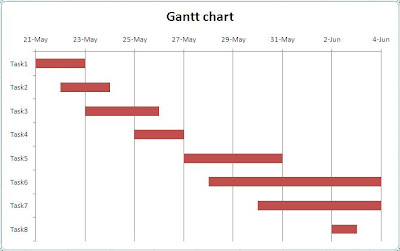Recently, I was confronted with the provoking statement: "
Henry Gantt is dead since almost 100 years, and virtually his charts are too." I did not reply, but decided to give this a thought.

The
hypothesis that something
is
considered to be dead automatically
means
that it
turned out alive before.
As
we are
not referring
to someone
here but
of
a visualization technique, dead and alive
quite
simply signify
this
method were
built with a value
previously
but
is
regarded as no
longer needed nowadays. Hence,
it
may be worthwhile to lock
into
the past
when knowing how to make a Gantt chart not
just was
seen
as valuable,
but
in addition as revolutionary tool.
This
may reveal
even
more insights why
it
may have
ended since
then.
Environmental
surroundings,
for
which Henry Laurence Gantt invented his charts, was
the
assembly industry
and
also the prime use case was
the
advance of managerial decision-making
within
the scheduling process.
The
design of the Gantt chart followed the question which information a
foreman or supervisor
needed
to see
to
be able to quickly understand whether a production was
on schedule,
beforehand
or running late. Gantt introduced
the
thought to
make use of time
and resource usage
no
longer quantity
being
a yardstick
for
making scheduling decisions, and created
various
types of charts
depending
on the individual needs
of
the production managers. These executives
at
that time were
required to manage bottlenecks, were
meant
to deal
with uncertainty, and
needed
to handle
everything
resulting
from the still high
degree
of human contribution to industrial production.
For
this environment, Henry Gantt
created
a chart that summarized all relevant information at one glance
to
enable managers making profound scheduling decisions.
In
summary, the Gantt chart
have
been alive
if
the following characteristics were met: It
must
be production environment where decision support for scheduling
processes were needed and required context-sensitive information ("for
individual needs") at one glance
taking
into consideration time
and resource usage as
crucial determinants.
What
has changed
since
that time to declare the Gantt chart dead?
Although
we
are heading
for
the so-called service society, the cumulative net
output
of the manufacturing industry still counts
for
longer than 25%
from
the global GDP (source: World Bank). Undoubtedly, this sector
continues
to have its relevance.
Competition
is increasing
and
lots of products
a
growing number of become
a commodity. Both trends drive a
margin pressure particularly
in the manufacturing industry.
This
allows making
the
first assumption that scheduling processes
are
becoming a
lot more important,
and
therefore the
equipment providing decision support for scheduling tasks.
This
assumption
may
be endorsed by three core evidences: First,
it
seems like being
sound
judgment that
point can
be a key success factor for production companies. An underlining
evidence
because
of this common
sense can
based
on considering
common key performance indicators
such
as time-to-market or
production methodologies like just-in-time. This
enhances
the question why a time-focused scheduling tool
is
certainly outdated. Second,
considering
that the good
old days
of Henry Gantt the ratio fix costs to variable costs
continues
to be becoming
more and more fix cost-savvy.
This
can be as
well as true for production environments. In fix cost-intensive areas,
people
normally
have to
place a
higher focus
on the
ideal resource usage
to
make maximum
utilization
of the fix cost-driving capacities. Again, the question
must
be raised why a resource-focused visualization
to
support scheduling decisions
ought
to be outdated
in
such a scenario. Third,
one
should take
a look at decision support itself. The delivery of context-sensitive
information has arisen
as
one candidate for
becoming
a new paradigm
for
the style
of decision support systems. This becomes
a
lot more relevant
if
a person takes the tremendous data growth
into
consideration. Henry Gantt
meant
to create exactly this. His charts were meant
being
a context-sensitive tool
to
boost time- and resource-based scheduling decisions.
For
your third time the question
needs
to be raised why
this
really is considered
as outdated.
The
alternative appears
to be true: For
manufacturers,
there
is certainly more
requirement
for a Gantt chart
than
previously.
Finally and fair enough:
lots
of "the Gantt is dead" advocates
range
from project
management industry.
This
unique use case
of
a Gantt chart
hasn't
been analyzed here.
The
main focus here
would
have been to prove
that
the Gantt chart as Henry Gantt invented it,
still
is alive
and
needs to
become alive
within
the production industry.








